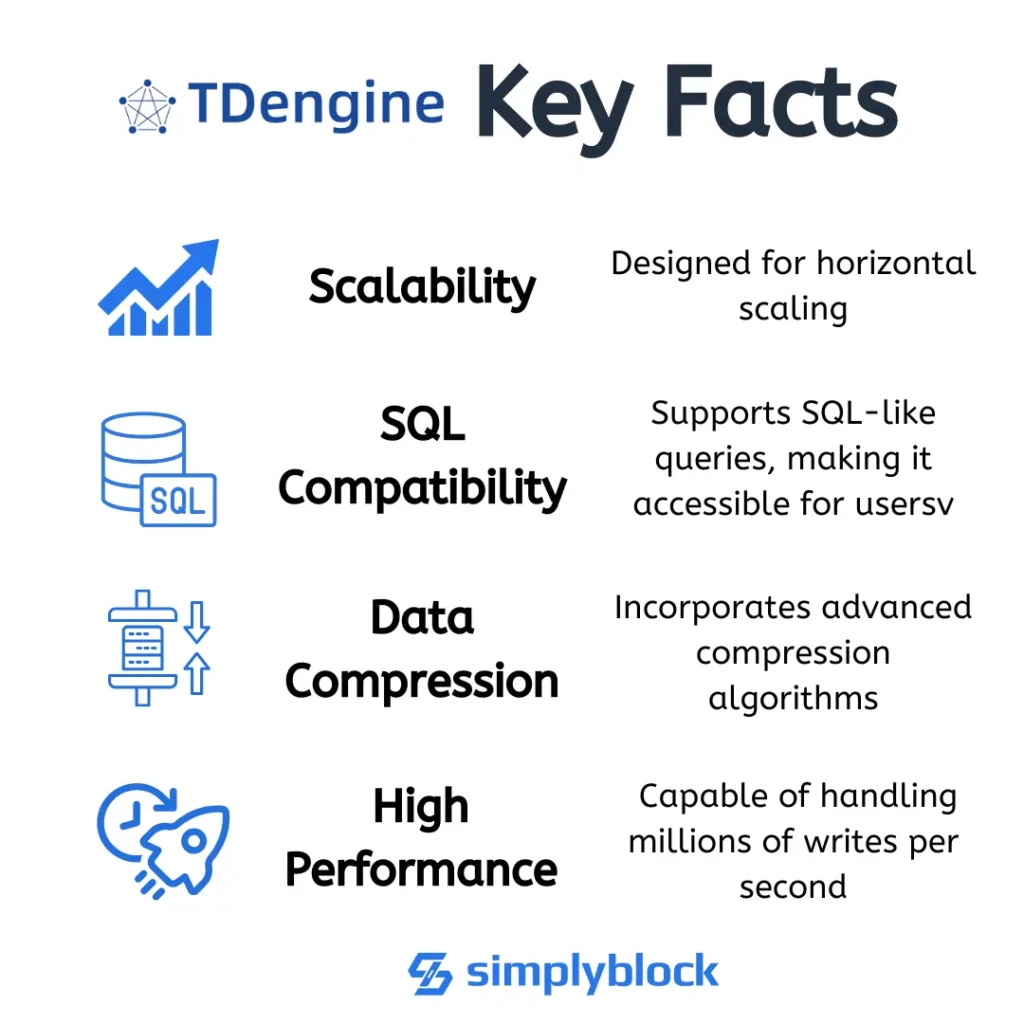TDengine
Terms related to simplyblock
TDengine is an open-source, time-series database (TSDB) optimized for high-ingestion, low-latency workloads. Built specifically for handling time-stamped data, TDengine is ideal for applications in IoT, Industrial Internet, energy, and real-time monitoring. It integrates database, caching, stream processing, and message queuing functionalities into a single lightweight platform, reducing system complexity and resource consumption.
How TDengine Works
TDengine uses a purpose-built architecture that stores time-series data in a highly compressed, columnar format. It minimizes storage overhead and maximizes write throughput by partitioning data by device and time intervals. Its multithreaded engine utilizes batch insertions and async writes to optimize I/O performance on modern SSD and NVMe drives.
TDengine supports SQL queries natively and is compatible with popular tools such as Grafana and Telegraf. It also includes native clustering for horizontal scalability, data replication, and high availability.
TDengine vs Other Time-Series Databases
While there are several TSDBs available, TDengine differentiates itself by integrating key functionalities into its core without requiring external components. Here’s how it compares:
| Feature | TDengine | InfluxDB / TimescaleDB |
|---|---|---|
| Write Performance | Millions of inserts/second | Moderate to high |
| Storage Efficiency | 10x compression with built-in algorithms | Depends on implementation |
| Architecture | Monolithic, lightweight | Plugin-heavy or PostgreSQL-based |
| Stream Processing | Built-in | External tooling needed |
| Message Queue | Native MQTT and Kafka integration | Requires external brokers |
TDengine’s all-in-one approach lowers operational complexity and enhances real-time data handling.

TDengine and NVMe-Optimized Storage
Time-series data is write-heavy, append-only, and often bursty. These characteristics align perfectly with NVMe over TCP and software-defined block storage provided by simplyblock™.
Running TDengine on top of simplyblock’s SDS allows for:
- Sub-millisecond latency for real-time dashboards
- Efficient batch inserts with low write amplification
- Erasure-coded durability without compromising IOPS
- Scalable ingestion nodes in Kubernetes or hybrid deployments
TDengine benefits from NVMe’s parallel I/O model and the platform’s scale-out architecture to support thousands of concurrent data sources.
TDengine in Kubernetes and Edge Environments
TDengine is container-native and supports deployment via Helm and Docker. However, persistent volumes for stateful sets require consistent performance and availability—especially at the edge where network constraints exist.
With simplyblock’s CSI integration, TDengine clusters can dynamically provision block storage with:
- Instant snapshot support
- Multi-zone high availability
- Volume-level encryption
- Optimized support for air-gapped or disconnected environments
This makes TDengine highly suitable for edge telemetry, industrial sensors, or remote monitoring workloads.
Storage Requirements for TDengine
A performant TDengine setup demands:
- High write IOPS for continuous, concurrent inserts
- Compression-aware storage to minimize disk consumption
- Fast recovery in case of node or zone failure
- Low read latency for alerting, trend analysis, and visualization
- Snapshotting for backup and model versioning
Simplyblock’s erasure coding ensures data durability while reducing the replication overhead common in traditional storage systems.
Use Cases for TDengine
TDengine is used across industries that rely on real-time, structured data streams:
- IoT device monitoring: Smart homes, connected vehicles
- Energy infrastructure: Grid telemetry, battery systems
- Industrial IoT (IIoT): SCADA, PLCs, predictive maintenance
- Telecom: Call detail records, signal monitoring
- Healthcare: Vital signs, wearable telemetry
By combining fast ingestion with high compression and streaming, TDengine reduces the time to insight in these critical environments.
Simplyblock™ Features Enhancing TDengine
TDengine’s benefits are amplified by simplyblock:
- NVMe-over-TCP for ultra-low-latency ingestion
- Erasure coding for resilient, space-efficient protection
- Copy-on-write snapshot and clone support
- Kubernetes-native volume lifecycle management
- Elastic scale-out with predictable cost and performance
Pairing TDengine with simplyblock ensures enterprise-grade reliability for time-series data infrastructure.
External Resources
- TDengine Official Website
- TDengine GitHub Repository
- Time-series database – Wikipedia
- Comparison of time-series databases – DB-Engines
- Grafana Integration with TDengine
Questions and Answers
TDengine is a purpose-built time-series database optimized for IoT, monitoring, and real-time analytics. It offers high ingestion rates, built-in caching, and minimal storage overhead, making it ideal for storing billions of data points across thousands of devices or sensors.
Yes, TDengine supports containerized deployments and can run in Kubernetes using StatefulSets. For optimal performance and persistence, combine it with Kubernetes-native NVMe storage to ensure fast ingestion and durable time-series storage.
Time-series workloads like TDengine benefit from NVMe over TCP, which delivers the high throughput and low latency needed for continuous writes, fast queries, and real-time analytics on massive datasets.
TDengine supports data security, but for stronger compliance and tenant isolation, it’s recommended to implement encryption at rest at the storage layer. This ensures secure, compliant deployments across cloud and on-prem environments.
Yes, TDengine is designed for scalable time-series ingestion and querying across millions of devices. When paired with software-defined storage, it can deliver consistent performance in edge, cloud, or hybrid architectures.
